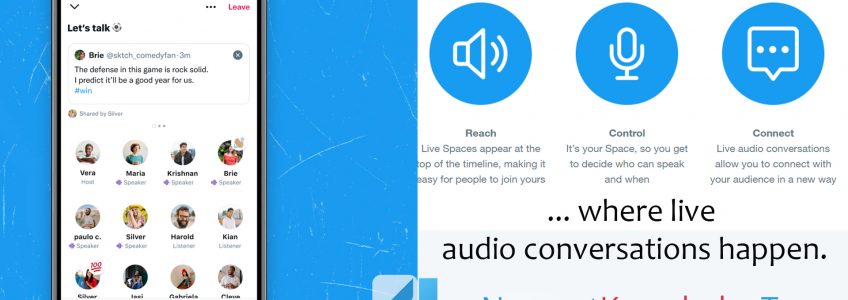
Understanding Twitter Spaces
Twitter Spaces is a new way to have live audio conversations on Twitter. What even is a Space, and why should you add it to your social media strategy? Here is a guide on the benefits and features of Spaces.
The conversation about you and your content is at its best on Twitter, and now you can Tweet and talk. Spaces unlocks conversations on Twitter with the depth and power only the human voice can bring. These ephemeral, live audio conversations allow for open, authentic, and unfiltered discussions, and there’s a Space for any and every topic and conversation, from small and intimate to millions of listeners. Twitter Spaces provides people with a new way to connect directly using their voice. The human voice can bring a layer of connectivity, emotion, nuance, and empathy that is often lost in text.
Visible to your followers at the top of their timeline, on the Spaces Tab, or in your Home Timelines, Spaces are a great way to jumpstart or join a conversation. Whether it’s announcing a new podcast, answering fan questions, or having a discussion with your co-host, Spaces can provide a bright spotlight on your conversation. Here are some Spaces thought starters specifically for podcasters.
Features & Functionality
Live audio
No need to be camera-ready — Spaces are audio, giving you the freedom and flexibility to start a conversation at any time, from anywhere. From home, on location, or at a sports game or awards show, you can bring the power of your voice straight to your audience.
Accessible and discoverable
At any point while hosting, listening, or speaking inside of a Space, you can tap the “Turn on captions” button, which will allow you to see live captions of any host or speakers who have consented to having their speech in Spaces captioned. Live Spaces appear highlighted in purple at the top of your followers’ timelines, making them easy to find and join, and you can assign up to three topics to a Space you host, to help make your Space more discoverable. We’re also testing out a Spaces tab (currently available in English and on iOS).
Share the mic
When you host a Space, you have complete control over mic access. Spaces can include up to 11 speakers at any one time, and once a Space has started, listeners can request speaker access from within the Space. Hosts can invite up to two co-hosts to help moderate the conversation, and hosts can also utilize safety tools to remove or block accounts.
Contextualize the conversation
Set the mood by adding context to your Space by giving it a descriptive name and sharing relevant Tweets directly within the Space. There’s no limit to the number of Tweets you can add, and anyone who can speak in the Space can share a Tweet. Adding Tweets can help drive the conversation, and you can include any Tweet you like — not just your own.
Twitter Spaces how-to guide
How to join a Space
Spaces are public and you can join one in one of three ways. Each Space has a public link that a host or listener can include in a Tweet, or share via a Direct Message. Live Spaces featuring a speaker or host you follow will also appear at the top of your timeline, highlighted in purple.
How to host a Space
To start a Space, long-press the compose button on your Home timeline, then select the cluster of dots icon. Your mic will be off when you first create your Space — tap Start your Space once you’re ready to begin speaking.
How to add a Co-Host
As a Host you can nominate up to two co-hosts, in addition to 10 speakers, within your Space to help moderate the conversation. Invite any current participant, or someone who isn’t in your Space. To do this, tap the Manage speakers icon, then Invite co-hosts to search for and select the accounts you’d like to co-host your Space, and send them an invite to let them know.
How to schedule a Space
Scheduling a Space in advance gives you a longer window to promote your upcoming conversation. To schedule a Space, long-press the compose button on your Home timeline, then select the cluster of dots icon. Give your Space a name, select up to three relevant topics, then tap the Calendar icon to select a date at time for your Space.
You can schedule one Space at a time up to fourteen days in advance, and you can still create impromptu Spaces in the meantime. To make a change to your upcoming Space, tap Edit to modify the name, date or time. Only the name of the scheduled Space can be modified once the Space is live
How to Tweet about your Space
Inform your audience and encourage them to join you by Tweeting about your Space in advance. To Tweet about it once your Space has started, click on the share menu in the bottom right corner to share your Space via Direct Message, Tweet card directly to your Home timeline, or copying the link.
How to share a Tweet within your Space
Help to guide the conversation and give context to your listeners by sharing a Tweet within your Space. To do this, navigate to the Tweet you want to include, tap the share icon, and select “Your Space” — don’t worry, your Space will remain active while you do this.
Ticketed Spaces and Recorded Spaces
This feature is currently being tested it will include two new Spaces features. on Ticketed Spaces and how to record, edit and share your next Space. Hosts can record their Space for anyone to listen to and share, to continue the conversation.
Keep the conversation going
Before going live, Hosts can choose to record the entirety of a Space, a scheduled Space, or a Ticketed Space. And anyone can replay a recording of a Space up to 30 days after the original broadcast has ended.
Edit the start time of your recording
Edit the start time of a recording so your listeners tune in right when the conversation starts. We’re also working on additional options for downloading audio and sharing clips of Spaces recordings.
Promote upcoming Spaces events
Share a recording to promote your podcast, live Space, virtual events, or your next scheduled Space.
Share it on your timeline and beyond
Anyone, except accounts you’ve blocked, can share your recording in a Tweet or DM — you can even embed it on your website for more visibility. And now, you can share a link to your Spaces recordings on different platforms.
Perks for listeners
- If they’re too busy and can’t join a live Space, people can playback your recording and catch up on the conversation anywhere for up to 30 days after recording is made.
- Everyone can share and distribute links to Spaces recordings to their own networks.
- Recordings also include the availability of closed captions so people can still follow along with or without audio.
How to record a Space
Before your Space starts
- Edit the name and description of your Space
- Select up to three Topics related to your Space
- Next to Record Space, tap the toggle to record your Space
- Tap Start a Space or the calendar icon to schedule your Space for a different date and time
After your Space ends
- Use the slider bar to edit the start time of your recording
- Share your recording via Tweet, DM, or embed it on your site so your followers and fans can catch up on the conversation
- On the Space card of your recording, hosts can view the total number of replays and participant count.
Downloading a recorded Space
Currently, it is not possible to download a Spaces Recording directly to your device as an audio file. However, as a Host, you can retrieve a copy of your Spaces recording within 30 days of the original broadcast date from your Twitter data archive as a .ts file that you can easily convert into an audio file like .mp3 or .wav, or even a video.
To download a Spaces Recording from your Twitter data archive:
- From the main menu of the Twitter App or twitter.com, click or tap Settings and privacy, then tap Your account.
- Next, click or tap Download an archive of your data. From that point, it may ask you to re-login to your account from your mobile web browser.
- Under Twitter data, click or tap the Request archive button.
- Twitter will notify you once your file download is complete.
- Upon downloading your archive, open the .zip file and navigate to data > spaces_media.
Please note: The ability to record Spaces is available to hosts on iOS & Android, but anyone can listen to a Spaces Recording on web, iOS and Android.
And now you can sell tickets to them.
Live audio conversations are happening on Twitter, and as a social media manager, journalist, Creator, or VIT, you’re probably already familiar with Twitter Spaces, right? Well say hello to Ticketed Spaces, a new way for you to earn money on Twitter, allowing you to host exclusive conversations, share bonus content, create personal connections, and monetize your audience.
We want you to get paid for what you love. Like making moments and conversations that matter.
With Ticketed Spaces, you can:
- Set the number of tickets.
- Choose a ticket price from $1 to $999.
- Share free invites with speakers, special guests, and more by DM.
Feed the hype
Ticketed Spaces leave fans wanting more exclusive conversations, bonus content, and personal interaction.
Find your biggest fans
Connect with the people who care about you and your content – and are ready to support you.
Make it personal
Set the size of your event at 5 or more to create closer bonds with your followers.
Spread the word
Remind attendees that your Space is happening with notifications to their phone and shared details in their timelines.
Gaming Spaces best practices
Here is a compiled a list of some of the best practices that we’ve seen across the gaming industry, as well as recommendations.
Pre-event excitement
Host a Space before a big event and have talent, players, or employees drop by over the course of the Space to tease what listeners can expect. This works particularly well ahead of esports events where players can drop-in and give their take on an upcoming match-up on their plate.
Watch parties for gaming or esports events
Why not share the excitement with some of your biggest fans by hosting a live Space while the match is going on? Coordinate with some hosts or partners that are clued into the game, and invite fans to come listen in real-time.
Post-announcement discussions
Use a Space to coordinate with guests who are close to the announcement to talk through it further and answer any questions directly from the community in real-time. This is particularly useful for new game announcements, esports events or roster updates, and any major news really.
Panels with industry professionals
Compile a roster of professionals or even internal employees at your company from different departments to talk through a particular subject in depth.
Good Practices for Spaces for Events and Gaming
Just finished a new game and want to chat with others who beat it? Why not fire up a Space to discuss what you just played with your friends and followers.
Before the Space
Assemble your Speakers. We typically recommend somewhere between three to five Speakers as it doesn’t put the onus on any one person to lead the conversation.
It’s a good idea to jot down an agenda or topics that you want to touch on. The more prepared you are, the better the Space will be. Listeners will typically appreciate a Host that is guiding the conversation and trying to keep it on track rather than aimlessly wandering around topics.
We recommend utilizing the schedule feature at least 24 hours before the actual Space.
From there, we recommend Retweeting or Quote Tweeting the original Tweet with the schedule card before the Space goes live to remind people to tune in.
During the Space
Try to get your guests into the Space and set up as Speakers as soon as possible so that Listeners aren’t waiting around. You also may want to appoint co-Hosts to manage moderation while the Space is happening.
Inform your audience and encourage them to join you by Tweeting about your Space while it’s happening. To do this, click on the share menu in the bottom right corner to share your Space via Direct Message, a Tweet card directly to your home timeline, or copying the link.
Once your Speakers are all in the room, go around the horn and have everyone make introductions, and give your audience a taste of what you’ll be discussing. From there, jump into your first topic.
As you touch on certain topics, you can share correlating Tweets within the Space to help guide the conversation. To do this, navigate to the Tweet you want to include, tap the share icon, and select “Your Space.” Don’t worry, your Space will remain active while you do this. Consider making a list of these shareable Tweets beforehand, so that it’s easy to share relevant Tweets in real time.
If you want to incorporate live Q&As into your Space, you have a couple of options here. The first being to let the audience raise their hands and ask questions live. This approach could be a bit risky as you can’t really moderate what people are going to say, so use your judgement of your audience and topics before going this route. In the event someone says something they shouldn’t, you can always report them and remove them from the Space immediately using the moderation tools.
Another approach to questions would be to set a hashtag prior to the Space and have Listeners Tweet their questions with the hashtag so you can source them with ease during the Space. You can have your Listeners Tweet directly at you and the other Speakers too.
Lastly, don’t be afraid to reset the room. Listeners will come in and out, so it’s OK to pause between topics to let new Listeners know what you’re talking about and where the conversation is heading.
Share journalism and talk radio best practices with students
Give back to the podcast community by making yourself available for student questions within a Space. Share the tools, tips, and tricks you wish you’d known when you were first starting out in the audio industry.
When first announcing your Space, include a poll to ask newbie podcasters what they would like to learn more about. This can increase awareness and engagement for your Space while also tailoring your content specifically for your audience.
Cross-promote the family of shows within your network
One of the benefits of Spaces is that you can have an audio conversation with anyone who is on Twitter. Invite the hosts of other shows within your organization or network to discuss what new shows or projects are coming up.
Hosting a Space with multiple speakers works as a great method for discovery and promotion — when you add someone as a speaker, the Space also becomes visible to their followers at the top of their Home timeline.
We look forward to seeing the creative and innovative Spaces that podcasters will share with their listeners. As a format that will feel second nature to podcasters, we’re excited to see how you host and participate in live audio conversations on Twitter.
After the Space
Thank your followers for joining the Space. If you’re planning on doing another one soon, be sure to mention that as well and potentially use the scheduling feature to get it out there.
Twitter Spaces FAQs
Who can join my Space?
Spaces are public and anyone can join as a listener.
Is there a time limit for Spaces?
There is no time limit for Spaces — each Space will be live until ended by the host.
Can I choose who is a speaker?
Yes. When you start the Space, you can add who you want to be a speaker or keep it open and anyone in the Space can request to be a speaker. Spaces can have up to 11 speakers at any one time, including the host.
How will people know about my Space?
Spaces are public. We encourage hosts to Tweet about upcoming Spaces they plan to start. And once a Space has been started, the host and anyone in the Space can share a Tweet and/or share a link of the Space directly from the share menu.
Once a Space has been started, anyone following the host or a listener will see the Space lit up in purple at the top of their timeline.
How can I remove someone from my Space?
The host can remove speaker permissions from anyone at any time, and can also remove anyone from the Space. This can be done by tapping on the person’s avatar within the Space, and tapping either “Block and remove” or “Report and remove.”
What safety controls exist?
Hosts of Spaces can control who has the ability to speak in their Space, and can also take action to “block and remove” or “report and remove” people from their Space. Speakers and listeners can report a Space, as well as report any account inside of a Space. Spaces will also show participants a warning when someone they block is speaking.












